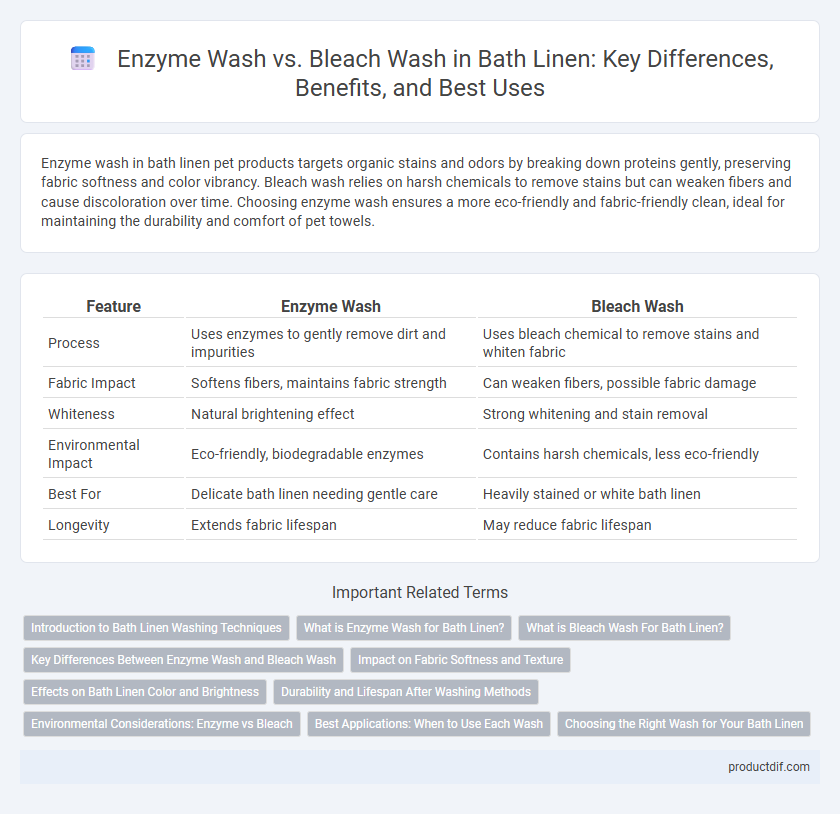Enzyme wash in bath linen pet products targets organic stains and odors by breaking down proteins gently, preserving fabric softness and color vibrancy. Bleach wash relies on harsh chemicals to remove stains but can weaken fibers and cause discoloration over time. Choosing enzyme wash ensures a more eco-friendly and fabric-friendly clean, ideal for maintaining the durability and comfort of pet towels.
Table of Comparison
| Feature | Enzyme Wash | Bleach Wash |
|---|---|---|
| Process | Uses enzymes to gently remove dirt and impurities | Uses bleach chemical to remove stains and whiten fabric |
| Fabric Impact | Softens fibers, maintains fabric strength | Can weaken fibers, possible fabric damage |
| Whiteness | Natural brightening effect | Strong whitening and stain removal |
| Environmental Impact | Eco-friendly, biodegradable enzymes | Contains harsh chemicals, less eco-friendly |
| Best For | Delicate bath linen needing gentle care | Heavily stained or white bath linen |
| Longevity | Extends fabric lifespan | May reduce fabric lifespan |
Introduction to Bath Linen Washing Techniques
Enzyme wash utilizes natural enzymes to gently break down protein-based stains on bath linen, preserving fabric softness while enhancing cleanliness. Bleach wash employs chemical agents to remove tough stains and whiten bath towels but may cause fabric weakening and color fading over time. Choosing between enzyme and bleach wash depends on desired fabric care, stain removal effectiveness, and maintaining the longevity of bath linen.
What is Enzyme Wash for Bath Linen?
Enzyme wash for bath linen involves treating fabrics with natural enzymes that gently break down starches and proteins, resulting in softer, cleaner towels with enhanced absorbency. This eco-friendly process minimizes fiber damage compared to bleach washing, preserving the fabric's strength and longevity. Enzyme washing also improves color retention and reduces chemical residues, making it a preferred method for maintaining high-quality bath linens.
What is Bleach Wash For Bath Linen?
Bleach wash for bath linen involves using a diluted bleach solution to lighten fabric color and remove stubborn stains, resulting in a brighter and cleaner appearance. This process enhances the fabric's whiteness and sanitizes the linen by eliminating bacteria and allergens. However, bleach washing must be carefully controlled to prevent fabric weakening and color damage.
Key Differences Between Enzyme Wash and Bleach Wash
Enzyme wash uses natural enzymes to gently break down stains and impurities on bath linen, preserving fabric softness and color vibrancy. Bleach wash involves chemical agents that aggressively remove stains and whiten fabrics but may weaken fibers and cause color fading. Enzyme wash is preferred for delicate, colored bath linens, while bleach wash suits heavily soiled white towels needing intense whitening.
Impact on Fabric Softness and Texture
Enzyme wash uses natural enzymes to gently break down fibers, enhancing fabric softness by creating a smoother texture without compromising durability. Bleach wash, on the other hand, relies on chemical agents that can weaken fibers and lead to a harsher, rougher fabric feel over time. Enzyme wash is preferred in bath linen production for maintaining softness and prolonging the luxurious tactile quality of towels and bathrobes.
Effects on Bath Linen Color and Brightness
Enzyme wash gently removes stains and dirt from bath linen, preserving the fabric's natural color and enhancing brightness without causing significant fading. Bleach wash, while effective at whitening, often leads to color degradation and fiber weakening, resulting in a duller appearance over time. Choosing enzyme wash maintains bath linen color vibrancy and fabric integrity longer than bleach wash alternatives.
Durability and Lifespan After Washing Methods
Enzyme wash enhances bath linen durability by breaking down natural fibers gently, resulting in a softer texture without significantly compromising fabric strength, thereby extending lifespan. Bleach wash, while effective at removing stains and whitening, can degrade fibers over time, leading to reduced fabric integrity and shorter product lifespan. Consistent enzyme-treated linen maintains better longevity through multiple wash cycles compared to bleach-treated alternatives.
Environmental Considerations: Enzyme vs Bleach
Enzyme wash in bath linen processing uses biodegradable enzymes that break down stains gently, reducing water pollution and energy consumption compared to bleach wash. Bleach wash relies on chemical agents like chlorine-based bleaches, which can release harmful byproducts such as dioxins into wastewater, posing risks to aquatic ecosystems. Choosing enzyme wash supports sustainable textile practices by minimizing environmental toxicity and promoting safer waste management.
Best Applications: When to Use Each Wash
Enzyme wash is best for delicate bath linen fabrics as it gently removes oils and impurities without damaging fibers, making it ideal for maintaining softness and absorbency in towels and bathrobes. Bleach wash works well for white or light-colored bath linens that require tough stain removal and deep sanitation, commonly used in hospitality settings where hygiene is critical. Choosing enzyme wash preserves fabric durability over time, whereas bleach wash provides a brighter, sanitized appearance for heavily soiled items.
Choosing the Right Wash for Your Bath Linen
Enzyme wash enhances bath linen by breaking down proteins and removing stains gently, preserving fabric softness and color vibrancy, ideal for delicate or colored textiles. Bleach wash offers superior whitening and disinfecting power, effectively removing tough stains and bacteria, making it suitable for white linens requiring hygienic maintenance. Selecting the right wash depends on fabric type, color fastness, and desired linen longevity, balancing stain removal with fiber preservation.
Enzyme wash vs bleach wash Infographic

 productdif.com
productdif.com